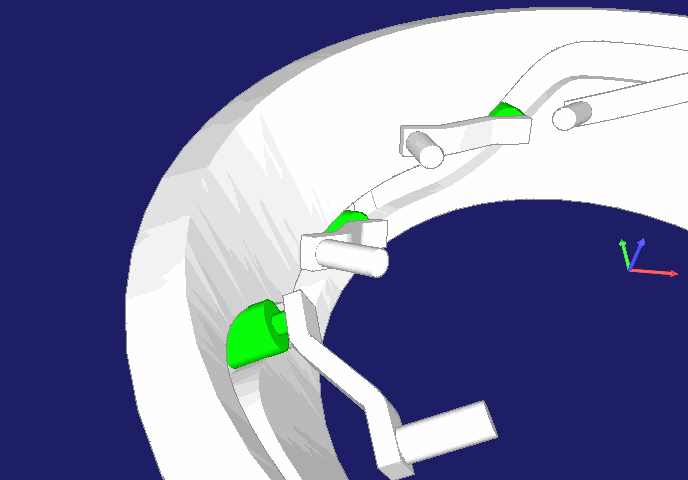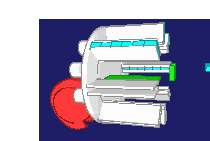Mechanisms
Suppose you are an engineer and you want to develop reliable motion control with the highest possible performance. For example, for a packaging machine or an assembly plant or a filling plant. It should be quick and inexpensive.
How would you do it?
With pneumatics?
Way too slow! In addition, compressed air is expensive.
With an NC control?
Again too slow! With NC controllers, you can design movement profiles only to a very limited extent. Motion overlaps are not possible.
With servo drives?
Too slow.
Servo drives always have to accelerate themselves, and the gear too.
It's as if a pole vaulter had to carry the staff over the crossbar.
No! Because ...
Mechanical solutions are still unsurpassed in terms of speed and process reliability:
- Cam Gears
- Linkages
- Indexing cam gears
- Wheels (also non-circular)
- Belts (also non-circular belts) and chains
With mechanics, so to say, the pole vaulter can collect energy during the entire start-up and release it at the moment of take-off.
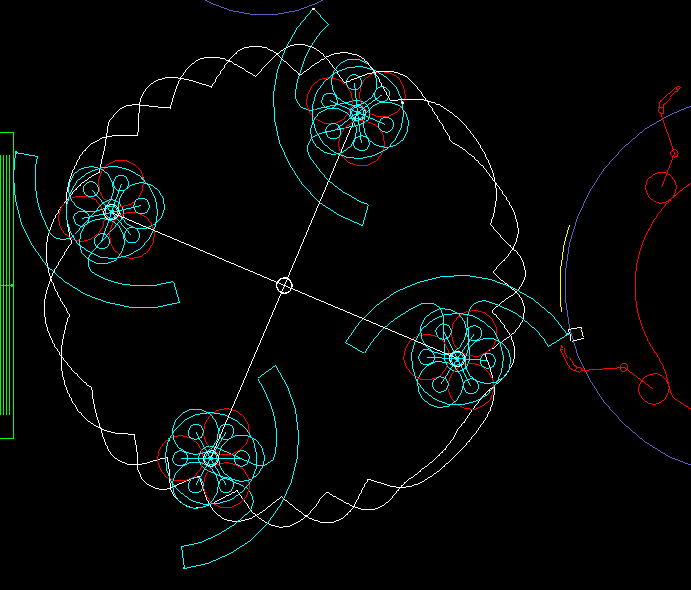
Good mechanical motion controls are marvels that exploit the play of kinetic and potential energies and mass forces to minimize the impact on the drive, and the mass forces cancel each other out.
Servo drives are flexible with regard to the motion sequences and thus the product formats, but by no means as performant as a well-designed mechanical motion control.
Not that a wrong impression arises here: We do not speak against servo drives!
We have also been optimizing motion control with servo drives for 25 years and creating PLC programs and data files for servo technology.
The demand for flexibility is widespread and often justified, and we are happy to follow it.
But is flexibility always reasonable?
Reasonable is an optimal price-performance ratio, a low TCO (Total Cost of Ownership).
If you build a machine that only uses a few and possibly even similar product formats during its lifetime, then what speaks against mechanical motion control?
Servo drives are often used today for movements that are never or only rarely changed in practice.
However, servomotors with gearboxes, converters, encoders, software, start-up programming, etc. are too expensive for that.
Mechanisms, ie mechanical motion controls with cams, gears, non-circular wheels, belts, chains, indexing gears and linkages, have many specific advantages:
- Mechanical motion controls are relatively inexpensive to purchase.
- They entail low indirect costs, eg energy costs.
- Taken together, this results in a low TCO (Total Cost of Ownership).
- Mechanics are quite insensitive to environmental influences such as temperature, humidity or dirt.
- Mechanical solutions work reliably and safely in the movement sequence.
- They are even somewhat flexible due to manual or motorized adjustments, eg by changing pivot points or lever lengths.
- Mechanics do not need much maintenance.
- It is user friendly.
- Mechanics are easy to repair, if necessary with a makeshift that keeps the machine running for urgent jobs.
- If cams or other mechanical components fail after a few years, you will always be able to obtain replacements. How long are electronic spare parts available? If a controller type is no longer produced after 10 years, what do you do if the controller fails?
- Mechanics are easy to put into operation. Screw it together and off you go. No configuration, no programming.
- Mechanical motion controls always run synchronized, without homing, even after an emergency stop.
- Faults and failures are very rare.
- If errors suddenly occur, they are easy to find and fix.
- You do not need software updates because mechanics have no software.
- Cam gears are automatically self-locking in the holding points, so that the drive does not have to apply a holding torque.
- Several working bodies and sub-mechanisms can mechanically exchange their kinetic energy with each other, so that the drive only has to apply a small residual torque or a small remaining power. An electrical energy exchange via intermediate circuits, however, always causes currents, heat and thus energy losses.
- With mechanics you can save a lot of energy. This is in the sense of environmental protection and a sustainable use of resources.
- Mechanical motion controls, especially with multiple movements, are very compact.
- They have a high energy density.
- Mechanical cams usually come with a cheap three-phase motor.
- Flywheels serve as energy buffers in mechanical solutions, so that smaller peak torques are required by the drive.
- Cams can be scanned in continuous operation of several rollers. This multiple use easily multiplies throughput.

To bring assemblies or entire machines on high speeds, especially the play of energies is interesting.
Two applications of this energetic optimization are particularly important:
1.) Power compensation or torque compensation
Few extra masses and possibly springs, cleverly placed, can drastically reduce the energy requirements of the entire system.
With additional compensation mechanisms, the drive power or the drive torque can be limited to frictional and process power, ie to the unavoidable minimum. We also optimize the dynamic parameters of the mechanics with special numerical optimizers.
2.) Mass balancing
The changing accelerations of the moving parts bring vibration into the machine frame. In crass cases, "the machine almost runs out of the hall", the mass forces are so strong on the frame that it fluctuates noticeably or gets twisted. The horizontally acting forces are often particularly unpleasant.
By skillful arrangement of masses or balancing mechanisms, the reaction of the masses on the frame can be compensated, theoretically completely. The mechanics are completely balanced at all times.
In a thermoforming machine with a double toggle effect, for example, we reduced the horizontal inertial force by 99%, simply by adding two masses at the right places.
Mechanism design and energetic optimization in machines are our specialties.
Benefit from our experience of 45 years of practice!
We support you with
- Motion design
- Servo drive design
- Collision optimization
- Mechanisms design
- Energetic optimization
Motion design optimizes machine motion for high performance, low vibration excitation, low energy consumption and long life. Machines with a good motion design are no more expensive to produce, but work much better! In our software OPTIMUS MOTUS we have a wide range of features for motion design.
In servo drive design, we choose the right motor/gearbox combination for your application. This selection is particularly tricky if the servo moves a non-linearly translating gear, such as the widespread crank. The driving torques resulting from self-inertia and external load are then not at all proportional to one another. Where the common "cam designers" and "sizers" stop, we are just starting!
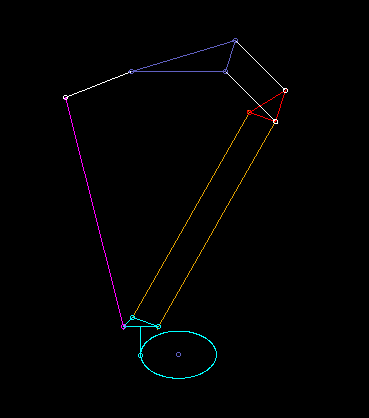
Collision optimization is a simple and effective way to make machines with multiple synchronized moves fast. Movements are optimally distributed along the time axis to reduce dynamic loads, while graphical simulations ensure that no collisions occur between competing axes.
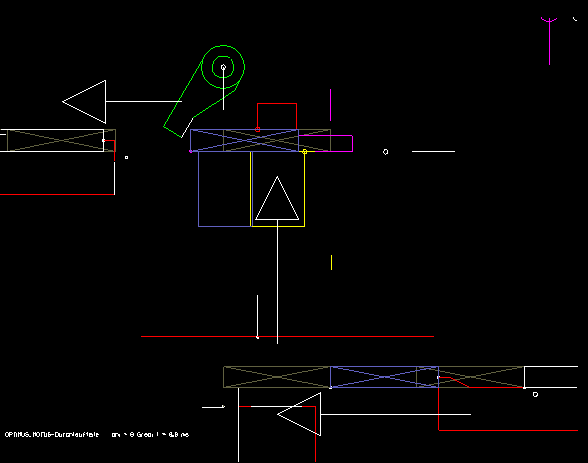
The design of mechanisms, ie mechanical motion controls, is unfortunately not quite simple. We are looking for simple, compact kinematic structures for your motion task and optimize the kinematic dimensions (lever lengths, angles, pivot points, etc.) using numerical methods (linkage synthesis).
The energetic optimization reduces the energy consumption of mechanisms, minimizes drive torques and drive power as well as the dynamic forces shaking the machine ground. For high-speed assemblies, energetic optimization is a very important component of mechanism design.
To the homepage of Nolte NC-Kurventechnik GmbH
Start CamDesign Indexing Kinematics Servo+PLC MotionDesign Training Software Service CamCalculation Imprint PrivacyPolicy
11/06/21
• Software OPTIMUS MOTUS ® /
DasNolte ®
• All types of Cam Calculations
• Performance Optimizations
• Trainings and consulting
• App and Software Development
• PLC Motion Software
Cams, Mechanisms, Motion Design. Faster Machines. Since 1965.
